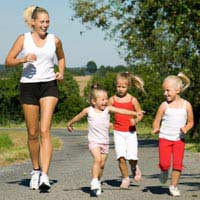A Career in Teaching Exercise to Children

Love exercise? Love kids? Ever thought about combining the two and making a career out of teaching exercise to kids?
With the increasingly couch-based lifestyle that many children have, the worries that parents have about allowing children to play outside, and the growing concerns about obesity, it’s important to get children exercising more at fun and imaginative sports exercise classes, whether in schools, at after school clubs, or at sports clubs and in the community at the weekends and in the holidays.
People who will be teaching children are likely to need a Criminal Records Bureau (CRB) check.
Teaching in Schools
One of the ways to teach sports and exercise to children is as a teacher in a primary or secondary school. There are a number of qualifications needed to go into teaching:- At least a grade C in English and maths GCSE (or equivalent standard) for primary and secondary teaching, with a grade C or equivalent in science (primary teaching)
- A degree
- An initial teacher training (ITT) course to gain qualified teacher status (QTS).
Alongside a Degree
Degree courses on education will lead to qualified teacher status, and some degree courses in a specialist subject also include QTS studies. Degrees usually take three or four years full-time or four to six years part-time.After a Degree
After completing a degree that doesn’t include a QTS qualification, graduates can train to gain a postgraduate certificate in education (PGCE). This is generally a full time course over one year or a part time course over two years, and can include distance learning.School-centred initial teacher training (SCITT) is generally full-time and takes one year, but will be based in a school and includes a lot more classroom experience and contact with children. Some SCITT courses lead to a PGCE, but all result in qualified teacher status.
Teaching Classes
If teaching in a school isn’t a calling, it’s possible to teach fitness and exercise to children and young people outside school hours, as after-school, weekend or holiday classes. These classes could be in fitness centres, youth clubs, or in community centres.Some colleges offer accredited certificates in teaching sports and exercise to children and young people, and these may specialise in certain age groups or in specific types of exercise, and may include health and nutrition as well. Accreditation bodies include CYQ (Central YMCA Qualifications). Look out for courses that are part of the National Qualifications Framework (NQF), including Level 2 qualifications – these allow an entry on the Register of Exercise Professionals (REPs), and may be required for working within fitness centres. The courses may be full- or part-time, and may be studied at a college or online.
- Is Your Child Doing Enough Exercise?
- Why Children With Close Friends Exercise More
- How to Keep Kids Fit on a Sensible Budget
- Fun Gadgets to Encourage Exercise
- Fun Facts: How Fast Can We Go?
- Kids Who Hate Exercise
- Yoga For Children
- Fitness Programs and Personal Trainers for Kids
- The Walking Bus
- Running and Kids
- How Much Exercise do Kids Need?
- Gymnastics
- Activity Recommendations for 5-12 Year Olds
- Climbing Frames and Other Equipment
- Dance and Musical Activity
- Activities for 9-11 Year Olds
- Activities for 6-8 Year Olds

Re: Compulsory PE in School
My son has just gone into Year 7 and I knew that he would have a hard time in PE. His co ordination isn't great and he has no interest in…
Re: Compulsory PE in School
My daughters in year 13 her school saying PE is compulsory.I have already stated that I feel this isn't true.She attends a special school…
Re: Activities for 3-5 Year Olds
I like the comments exercise is very important for young children
Re: Compulsory PE in School
My son is 8 yrs old and was in football club today. When I came to pick him up they were in shorts and t-shirt outside in heavy rain he…
Re: Compulsory PE in School
I see some comments on here saying that PE is compulsory, however, the Education Act of 2002 prohibits the Secretary of State for…
Re: Compulsory PE in School
I'm in Year 10 and P.E is made a living hell for me, the girls in the class shout at you and put you down swearing at you and telling you…
Re: Compulsory PE in School
There is more to pe than simply sports. It is good for growing brain cells (for real). It is good for social skills (if delivered…
Re: Compulsory PE in School
My son went through he'll at school because of his bullying pe teacher my son has a pigeon chest and shortness of breath and is currently…
Re: Compulsory PE in School
I’m 12 and PE in my opinion is stupid. To me, it’s an entrance ticket for bullying. My school especially needs to understand not everyone…
Re: Active Games for Teens
wow interesting thanks this is my essay!@!!!!!!!!!!!!!!!!